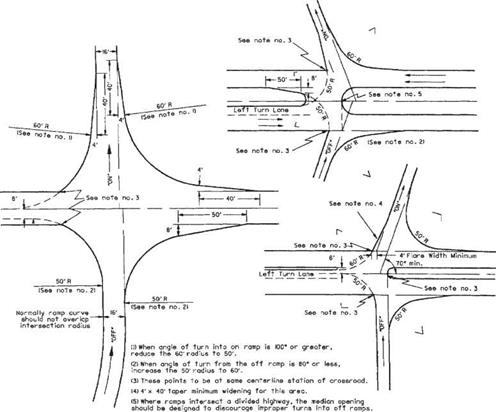COLLECTOR-DISTRIBUTOR ROADS
Collector-distributor (C-D) roads are used to minimize weaving problems and reduce the number of conflict points (merging and diverging) on the mainline. C-D roads may be used within a single interchange, through two adjacent interchanges, or continuously through several interchanges.
When a C-D road is provided between interchanges, a minimum of two lanes should be used. Either one or two lanes may be used on C-D roads within a single interchange. The cross-section elements for one – and two-lane C-D roads should be in accordance with the criteria for one-lane and two-lane directional roadways provided in Fig. 2.27. The separation between the mainline and C-D road pavements should be designed to prevent, or at least discourage, indiscriminate crossovers. As a minimum, the separation should be wide enough to provide normal shoulder widths for both the mainline and C-D road roadways plus a suitable median. Normally, a standard concrete barrier median is used, since C-D road separation often involves obstructions such as bridge parapets, piers, or overhead sign supports. There may be isolated cases where a lesser – type median may be used.
![]()

2.6.2 C-D Road Entrance and Exit Terminals
Figure 2.45a shows both high-speed and low-speed C-D road entrance terminals. The high-speed collector-distributor entrance terminal is intended for use on rural interstate highways and other freeways where high-speed design has been designated. The low-speed collector-distributor entrance terminal is intended for use on all other freeways. Three exit terminal lane conditions are shown on Fig. 2.45b. These terminal designs are to be applied to highways using either high-speed or low-speed terminals.
Superelevation at C-D terminals should be developed similar to that prescribed for standard ramp terminals.






Leave a reply